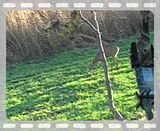dbltree
Super Moderator
Re: Switchgrass - Planting switchgrass with corn
 )
)
Sooner would be better just so it can kind of rot down a little and not be a mat of heavy grass that seed can't penetrate...
A post was made earlier about planting switchgrass with corn so I'm adding it to this thread because it is an excellent way to establish switchgrass.



The total planting was 14 acres, two of which was frost seeded. Just as I started to seed in mid March the ground thawed and was just too soft to run the drill across so I planted the bulk of the switch grass in mid-May along with the corn. June was unusually cool and wet which slowed the corn growth down in my area and I was guessing would do the same to the switch. So I decided to press my luck and spray atrazine and round up in mid June. In July we finally got some hot sunny days and the switch finally popped up and has grown well ever since. Some of the switch that has went to seed is near chest high, but most is knee to waist high.
Surpisingly the ground that was worked and planted to switch in May looks better and with fewer weeds than the grass that was frost seeded in March. Most of the weed competition is from broadleafs in this area and not foxtail or other grasses so the switch is growing pretty well in this area to spite the weeds.
Now I'm trying to decide whether to harvest the corn or to leave it stand into next season and I see positves and negatives to both. If the corn stands into next spring it will be good cover and food this fall and may be easier to spot/frost seed switch in some thin spots this winter. I assume the debris left behind from the combine will cover the ground and make it more difficult to frost seed.
However if the corn is down I could spray the broadleaf weeds early next spring before the switch germinates. Another plus is that the corn is worth probably around 3-4 grand which would cover the expences of seed and chemicals quite nicely...
Dbltree whats your take on the question of harvesting the corn say in November after the switch is dormant?
You bet!! (assuming you have a tractor by then...could I go in there with my rotary mower in the winter or simply BEFORE I frost seed or drill to get rid of some of the JUNK on top????
Sooner would be better just so it can kind of rot down a little and not be a mat of heavy grass that seed can't penetrate...
A post was made earlier about planting switchgrass with corn so I'm adding it to this thread because it is an excellent way to establish switchgrass.
Here is some pics of my corn/switchgrass plots planted mid-May of this year. I gained alot of info from this site which really helped me to be successful on this project.



The total planting was 14 acres, two of which was frost seeded. Just as I started to seed in mid March the ground thawed and was just too soft to run the drill across so I planted the bulk of the switch grass in mid-May along with the corn. June was unusually cool and wet which slowed the corn growth down in my area and I was guessing would do the same to the switch. So I decided to press my luck and spray atrazine and round up in mid June. In July we finally got some hot sunny days and the switch finally popped up and has grown well ever since. Some of the switch that has went to seed is near chest high, but most is knee to waist high.
Surpisingly the ground that was worked and planted to switch in May looks better and with fewer weeds than the grass that was frost seeded in March. Most of the weed competition is from broadleafs in this area and not foxtail or other grasses so the switch is growing pretty well in this area to spite the weeds.
Now I'm trying to decide whether to harvest the corn or to leave it stand into next season and I see positves and negatives to both. If the corn stands into next spring it will be good cover and food this fall and may be easier to spot/frost seed switch in some thin spots this winter. I assume the debris left behind from the combine will cover the ground and make it more difficult to frost seed.
However if the corn is down I could spray the broadleaf weeds early next spring before the switch germinates. Another plus is that the corn is worth probably around 3-4 grand which would cover the expences of seed and chemicals quite nicely...
Dbltree whats your take on the question of harvesting the corn say in November after the switch is dormant?
Last edited:















